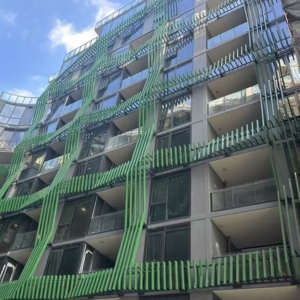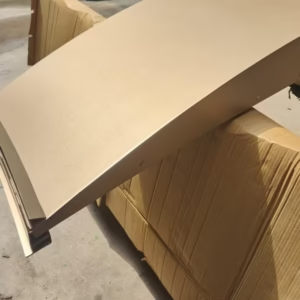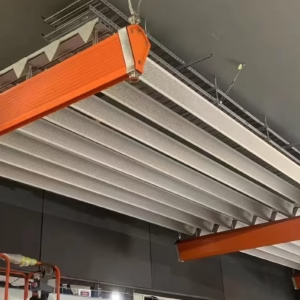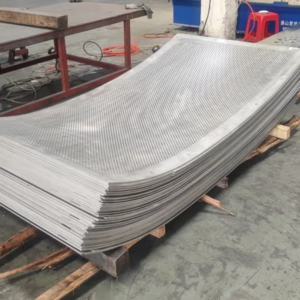Project Background and Development Status
Commercial Building Market Demand Analysis
The demand for commercial buildings has been growing steadily, driven by urbanization, economic development, and increasing investments in infrastructure. Modern commercial architecture emphasizes aesthetic appeal, functionality, and sustainability, making aluminum curtain walls a preferred choice due to their lightweight structure, durability, and versatility. The market expansion is further fueled by the need for energy-efficient and environmentally friendly building solutions.

Importance and Application Trends of Aluminum Curtain Walls in Modern Architecture
Aluminum curtain walls have become a crucial component in contemporary architectural design due to their numerous advantages. These include enhanced thermal insulation, improved structural integrity, and the ability to integrate innovative technologies such as photovoltaic panels and smart shading systems. Their application spans across high-rise office buildings, shopping malls, hotels, and institutional facilities, contributing to modern urban skylines. The rising preference for sleek, high-performance facades has accelerated the adoption of aluminum curtain wall systems in both new constructions and renovation projects.
Market-Driven Factors for Sustainable and Energy-Efficient Design
The push for sustainability and energy efficiency in the construction sector has significantly influenced the development of aluminum curtain walls. Key market drivers include:
- Regulatory Compliance & Green Building Certifications – Governments worldwide are enforcing stricter energy regulations, promoting the use of eco-friendly materials and technologies that reduce carbon footprints. Certifications such as LEED (Leadership in Energy and Environmental Design) and BREEAM (Building Research Establishment Environmental Assessment Method) encourage developers to adopt sustainable facade systems.
- Energy Cost Reduction – Aluminum curtain walls with thermal breaks, double-glazing, and intelligent ventilation systems help reduce energy consumption by improving insulation and optimizing natural lighting.
- Aesthetic and Functional Adaptability – Architects and developers seek innovative facade designs that balance aesthetics with performance, leading to the demand for customizable aluminum curtain wall solutions with advanced coatings and surface treatments.
- Technological Innovations – The integration of smart building technologies, self-cleaning coatings, and high-performance materials ensures long-term efficiency, reducing maintenance costs and enhancing overall building sustainability.
As urban landscapes evolve, aluminum curtain wall systems continue to play a pivotal role in shaping sustainable, energy-efficient, and aesthetically pleasing commercial buildings. The future of this industry lies in innovation, material advancements, and strategic collaborations between architects, engineers, and manufacturers.
In-Depth Analysis of Aluminum Curtain Wall System Design Theories and Technical Requirements
I. Basic Design Principles
1. Aesthetic Appeal and Architectural Style Unity
As an essential component of a building’s facade, the aluminum curtain wall must be designed in harmony with the overall architectural style. For instance:
- In the Emerson Los Angeles project, a metal panel system composed of 17 types of folded aluminum components provides shading and privacy, seamlessly integrating with the building’s functions.
- The Harbin Opera House features smooth white aluminum panels on its facade, with delicate details at the edges and surface, blending with the surrounding wetland landscape.
- The selection of colors and textures should consider the building’s overall style and surrounding environment. For example, a blue-themed color palette adds vibrancy without being overly loud in an urban renewal project.

2. Structural Safety, Stability, and Durability
- Material Requirements: High-quality aluminum alloy materials with a thickness of no less than 2.5mm should be selected, ensuring good weather resistance and corrosion resistance.
- Structural Design: Consider performance requirements such as wind load resistance, watertightness, and thermal insulation. For example, high-strength, corrosion-resistant materials should be used for the aluminum curtain wall‘s hanging parts and connectors to ensure stability and sealing.
- Construction Practices: Clean the base wall before installation to ensure firm bonding. Pay attention to construction techniques during installation to avoid mechanical damage to the aluminum panels or sealing performance.

3. Energy Efficiency and Building Thermal Performance
- Material Selection: Aluminum is recyclable, with low energy consumption and environmental impact. Coating materials should meet environmental standards, avoiding harmful substances.
- Energy Efficiency: Focus on thermal insulation, sound insulation, and UV resistance. Use efficient thermal insulation materials and structural designs to reduce building energy consumption. For example, optimizing the thermal performance of double-glazed curtain walls can significantly improve energy efficiency.
- Environmental Harmony: The aluminum curtain wall design should coordinate with the surrounding environment, using colors, textures, and other elements to minimize landscape disruption and visual pollution.

II. Structural Design and Mechanical Analysis
1. Structural Calculations Under Wind Load, Earthquake, and Other External Forces
- Wind Load Calculation: Calculate the wind pressure on the curtain wall based on local climatic conditions to ensure structural safety.
- Seismic Action Calculation: Consider the impact of earthquakes on the curtain wall and design for seismic resistance to ensure stability and safety under seismic action.
2. Connection Node Design, Load Transfer, and Deformation Resistance
- Connection Node Design: Use high-strength, corrosion-resistant connectors to ensure reliable connections between the curtain wall and the main structure.
- Load Transfer: Through reasonable structural design, ensure that loads are effectively transferred to the main structure.
- Deformation Resistance Design: Consider factors such as temperature changes and load effects, design deformation joints and expansion joints to prevent damage to the curtain wall due to deformation.
3. Calculation Methods and Software Applications (Finite Element Analysis, etc.)
- Finite Element Analysis: Use finite element analysis software to simulate and analyze the curtain wall structure, predict its response under different loads, and optimize the structural design.
- Other Calculation Methods: Combine theoretical calculations and engineering experience to comprehensively analyze the curtain wall structure, ensuring design rationality and economy.
III. Material Selection and Surface Treatment Technologies
1. Performance Comparison of Common Aluminum Alloy Materials (e.g., 3003, 5005, 6061)
- 3003 Aluminum Alloy: Good formability and corrosion resistance, suitable for general building curtain walls.
- 5005 Aluminum Alloy: Higher strength and good corrosion resistance, suitable for curtain walls requiring higher strength.
- 6061 Aluminum Alloy: High strength, excellent corrosion resistance, suitable for high-rise building curtain walls.
2. Surface Treatment Processes: Anodizing, Electrophoretic Coating, Powder Coating, Fluorocarbon Coating
- Anodizing: Improves the hardness and corrosion resistance of the aluminum surface, forming an oxide film and enhancing decorative effects.
- Electrophoretic Coating: Uniform coating, strong adhesion, good weather resistance, and decorative properties.
- Powder Coating: Controllable coating thickness, rich colors, good weather resistance, and corrosion resistance.
- Fluorocarbon Coating: Excellent weather resistance and corrosion resistance, suitable for high-end building curtain walls.
3. Environmental Friendliness, Weather Resistance, and Economic Evaluation of Materials
- Environmental Friendliness: Choose recyclable aluminum materials, with coating materials meeting environmental standards to reduce environmental impact.
- Weather Resistance: Consider the weather resistance performance of the curtain wall when exposed to the outdoor environment for a long time, selecting materials and surface treatment processes with good weather resistance.
- Economic Efficiency: On the premise of meeting usage requirements, choose cost-effective materials and processes to reduce project costs.
IV. Energy Efficiency, Environmental Protection, and Intelligent Design
1. Synergistic Effects of Low-E Glass, Vacuum Glass, and Curtain Wall Systems
- Low-E Glass: Reduces indoor heat loss and improves building insulation performance.
- Vacuum Glass: Excellent thermal insulation performance, reducing indoor and outdoor heat transfer and lowering building energy consumption.
2. Intelligent Lighting, Photovoltaic Integration, and Automatic Ventilation System Adjustment
- Intelligent Lighting: Automatically adjust the opening and closing of blinds or shading systems based on indoor lighting needs, making full use of natural light and reducing artificial lighting energy consumption.
- Photovoltaic Integration: Integrate solar photovoltaic panels with the curtain wall to utilize solar energy for power generation, providing clean energy for the building.
- Automatic Ventilation System Adjustment: Automatically adjust the opening and closing of the curtain wall’s vents based on indoor and outdoor environmental conditions to achieve natural ventilation and reduce air conditioning energy consumption.
3. Green Building Standards and LEED Certification Requirements
- Green Building Standards: Follow relevant standards such as the “Green Building Evaluation Standard” to ensure the curtain wall design meets performance requirements in energy conservation, environmental protection, and comfort.
- LEED Certification Requirements: Meet LEED certification requirements in sustainable sites, water conservation, energy and atmosphere, materials and resources, and indoor environmental quality to enhance the building’s overall quality and competitiveness.
Through this comprehensive analysis of design theories and technical requirements, the aluminum curtain wall system can achieve the goals of aesthetics, safety, durability, energy efficiency, and intelligence, providing high-quality facade solutions for modern buildings.
Aluminum Curtain Wall Installation Technology and Construction Management
I. Pre-construction Preparation
1.1 Site Survey, Measurement, and Setting Out
Before starting the aluminum curtain wall construction, a comprehensive site survey is necessary. This mainly focuses on the stability of the building structure, wall flatness, and the locations of existing obstacles (such as doors, windows, and pipelines). The measurement work requires the use of precision instruments such as laser rangefinders and levels to ensure accurate wall dimension data is obtained. Setting out involves marking key control lines on the wall according to the design drawings, such as the installation positions of the keel and the division lines of the curtain wall panels.
1.2 Material Prefabrication and Factory Processing Flow Control
The main materials for aluminum curtain walls include aluminum alloy profiles, glass/aluminum panels, sealants, etc. The factory processing needs to strictly control the cutting accuracy, with the cutting error of aluminum alloy profiles controlled within ±0.5mm. CNC machining centers are used for profile drilling, milling, and other processing to ensure that the processing dimensions match the drawings. After processing, surface treatment (such as anodizing, fluorocarbon spraying) is required, and the surface quality is strictly inspected.
1.3 Construction Drawings, Detail Drawings, and Technical Disclosure
Before construction, it is necessary to organize technical personnel and construction teams to review the design drawings, focusing on verifying the connection nodes between the curtain wall and the main structure, lightning protection and grounding design, drainage structure, and other key nodes. Technical disclosure should explain in detail the construction process flow, quality acceptance standards, safe operation specifications, and other content to ensure that the construction personnel fully understand the design intent and construction requirements.
II. Installation Process Flow
2.1 Installation of Base, Keel, and Frame Structure
The installation of the base is the foundation of aluminum curtain wall construction, usually using embedded parts or post-installed anchor bolts to connect with the main structure. The deviation of the embedded parts should be less than 20mm, and the post-installed anchor bolts need to undergo a pull-out test to ensure their bearing capacity meets the design requirements. The keel installation requires installing the vertical keel first, then the horizontal keel, using stainless steel bolts for connection to ensure the overall stability of the frame.
2.2 Installation and Fixing Technology of Curtain Wall Panel Units
Before installing the curtain wall panel units, it is necessary to inspect their processing quality to ensure accurate dimensions and no scratches on the surface. During installation, special gondolas or lifting platforms are used for high-altitude operations. First, connect the curtain wall panel units with the keel, then fine-tune them using adjustable brackets to ensure a flat panel surface and uniform joints. The fixing method adopts self-tapping screws, pressure plate fixing, or hook fixing according to the design requirements.
2.3 Joint Treatment, Sealing, Waterproofing, and Windproof Measures
Joint treatment is a key part of aluminum curtain wall construction, directly affecting the waterproofing and windproof performance of the curtain wall. The joints need to be filled with weather-resistant sealant. Before injecting the sealant, clean the joint surfaces to ensure no oil or dust. The sealant injection should be full and continuous, avoiding air bubbles and gaps. At the same time, waterproof flashing should be installed at the top and bottom of the curtain wall to prevent rainwater infiltration.
2.4 Various Installation Methods: Comparison of Exposed Frame, Hidden Frame, and Semi-hidden Frame Installation Technologies
| Installation Method | Characteristics | Applicable Scenarios |
|---|---|---|
| Exposed Frame Installation | Aluminum alloy frame is exposed, with clear structure | Buildings emphasizing line aesthetics |
| Hidden Frame Installation | The frame is hidden inside the curtain wall panel, with a clean appearance | Modern-style high-rise buildings |
| Semi-hidden Frame Installation | Horizontal or vertical frame is exposed | Buildings requiring both aesthetics and structural requirements |
III. Construction Safety and Quality Control
3.1 Safety Protection and Personnel Training During Construction
High-altitude operations require the use of safety belts, safety nets, and other protective facilities. Check the safety performance of scaffolding and gondolas before operations. Construction personnel undergo pre-job safety training to familiarize themselves with safety operation procedures and emergency response measures. Regular safety drills are conducted to improve the safety awareness and emergency response capabilities of construction personnel.
3.2 Site Construction Management and Construction Records
A strict management system needs to be established on the construction site to clarify the responsibilities of each position and ensure orderly construction. Construction records should include hidden project acceptance records, quality inspection records, safety disclosure records, etc., to provide a basis for project acceptance and later maintenance.
3.3 Quality Inspection Methods, Acceptance Standards, and Post-maintenance Requirements
Quality inspection includes appearance quality inspection, dimension deviation inspection, sealing performance inspection, etc. The acceptance standards should meet the requirements of relevant specifications such as the “Technical Code for Building Curtain Wall Engineering”. Post-maintenance requires regular cleaning of the curtain wall surface, inspection of the aging of sealants, and timely replacement of damaged parts.
IV. Construction Schedule and Cost Control
4.1 Project Schedule Plan and Key Node Control
Before construction, it is necessary to formulate a detailed project schedule plan, clarifying the construction tasks and completion times for each stage. Key node control includes material arrival time, keel installation completion time, curtain wall panel installation completion time, etc., to ensure the project is completed on schedule.
4.2 Material Procurement, Transportation, and On-site Storage Management
Material procurement requires selecting reputable suppliers to ensure material quality. Protective measures are taken during transportation to avoid material damage. On-site storage requires classified storage to prevent moisture and deformation.
4.3 Construction Cost and Installation Efficiency Optimization Strategies
By optimizing the construction plan, adopting advanced construction machinery, improving the skill level of construction personnel, and other measures, construction costs can be reduced, and installation efficiency can be improved. At the same time, strengthen on-site construction management to reduce material waste and labor idling.
As an important element of modern commercial buildings, the installation technology and construction management of aluminum curtain walls are directly related to the safety, aesthetics, and service life of the building. Through refined construction management and technological innovation, it is possible to ensure the high-quality and efficient completion of aluminum curtain wall projects, adding unique charm to commercial buildings.




